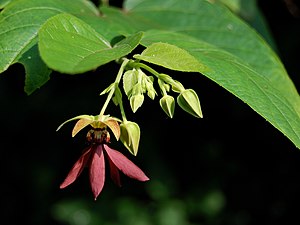Note: This is a project under development. The articles on this wiki are just being initiated and broadly incomplete. You can Help creating new pages.
Abroma augusta - Ulat kambal
Abroma augusta is a large, spreading shrub or small tree sometimes growing up to 10 metres tall, but more generally 1 - 4 metres when in cultivation. The plant provides a high quality fibre that is mainly used locally. It also has local medicinal uses. Often harvested from the wild, it is also sometimes cultivated in tropical areas as a fibre crop and is sometimes grown as an ornamental.
Uses
Parts Used
Chemical Composition
The root contains abromine (betaine), friedelin, abromasterol, abromasterol A, choline, beta-sitosterol, stigmasterol and octacosanol. Leaves, reported to be useful in treating uterine disorders, contain taraxerol, its acetate and lupeol. [2]
Common names
| Language | Common name |
|---|---|
| Kannada | |
| Hindi | Ulat kambal |
| Malayalam | |
| Tamil | Sivappututti |
| Telugu | |
| Marathi | NA |
| Gujarathi | NA |
| Punjabi | NA |
| Kashmiri | NA |
| Sanskrit | Yoshini, Pivari |
| English | Devil's cotton |
Properties
Reference: Dravya - Substance, Rasa - Taste, Guna - Qualities, Veerya - Potency, Vipaka - Post-digesion effect, Karma - Pharmacological activity, Prabhava - Therepeutics.
Dravya
Rasa
Tikta (Bitter), Katu (Pungent)
Guna
Laghu (Light), Rooksha (Dry)
Veerya
Ushna (Hot)
Vipaka
Karma
Kapha, Vata
Prabhava
Habit
Identification
Leaf
| Kind | Shape | Feature |
|---|---|---|
| Simple | alternate | Leaves 10-20 (-30) x 5-15 (-25) cm; ovate-lanceolate, ovate-oblong, cordate at base, acute or acuminate at apex, repand-denticulate, glabrescent above, tomentose beneath; petioles 1.5-2.5 cm long; stipules linear, as long as the petiole, deciduous. |
Flower
| Type | Size | Color and composition | Stamen | More information |
|---|---|---|---|---|
| Bisexual | subterminal or axillary peduncled cymes | Maroon | 5 cm in diameter. Sepals ca 2 x 0.6 cm, lanceolate, connate at base, persistent. Petals ca 2.8 x 1.2 cm with hooded ca 5 mm long claw and spoon- shaped lamina, claws hairy outside. Stamens 3 in each group in the sinus; staminodes ca 2x1 mm, hairy, emarginate. Ovary 2.5-3 x 2 mm, oblong, 5- lobed, sessile; styles ca 2 mm long |
Fruit
| Type | Size | Mass | Appearance | Seeds | More information |
|---|---|---|---|---|---|
| Capsule | 3.5-4 cm long | obpyramidal, membranous, 5-angled, truncate at apex, septicidally 5-valved, valves villous at the edge | seeds many, ca 3 x 2 mm, obovate. | {{{6}}} |
Other features
List of Ayurvedic medicine in which the herb is used
Where to get the saplings
Mode of Propagation
How to plant/cultivate
Prefers hot and humid climate. Mature seeds are collected during December-January The seeds are sown in well-prepared nursery beds or polybags during February to mid-March. For better germination seeds may be given treatment with dilute sulfuric acid for 6 minutes and then thoroughly washed. Germination occurs in 12-15 days. [5]
Commonly seen growing in areas
Photo Gallery
References
External Links
- Ayurvedic Herbs known to be helpful to treat Gynecological disorders
- Ayurvedic Herbs known to be helpful to treat Induces menstruation
- Ayurvedic Herbs known to be helpful to treat Arthritis
- Ayurvedic Herbs known to be helpful to treat Bronchitis
- Ayurvedic Herbs known to be helpful to treat Fever
- Herbs with Root used in medicine
- Herbs with common name in Hindi
- Herbs with common name in Tamil
- Herbs with common name in Sanskrit
- Herbs with common name in English
- Habit - Shrub
- Index of Plants which can be propagated by Seeds
- Index of Plants which can be propagated by Cuttings
- Herbs that are commonly seen in the region of Tropical area
- Herbs that are commonly seen in the region of Sub tropical area
- Herbs
- Shrub
- Malvaceae




